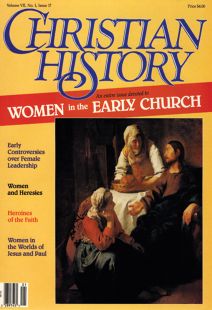Christian History Timeline: Women and the Church Orders
Events
1–90 A.D.
Pentecost (c. 30 A.D.)
Spread of faith despite persecution by Nero and Domitian
Phoebe
90–200 A.D.
Consolidation of church; spotty, localized persecution
Clement
Justin Martyr
200–300 A.D.
Sharp persecution, especially in North Africa under Septimius Severus
Origen, Tertullian make Christianity intellectually respectable.
Church becomes more respectable, builds buildings
Blandina martyred
Perpetua martyred
Decius stuns church with persecution; Valerian continues it
Church tries to rebuild
Origen martyred
300–400 A.D.
Diocletian launches Great Persecution (303–310)
Edict of Toleration (311)
Constantine converts, begins co-regency (313)
Constantine makes Christianity the religion of the empire (324)
Helena visits Holy Land
John Chrysostom
Paula
Monica dies
Jerome in Rome
400–500 A.D.
Alaric the Goth sacks Rome (409–410)
Pulcheria rules empire
Augustine is bishop of Hippo
Key Writings
Didache (100–200 A.D.)
Recognized those with the Spirit, gave guidelines for their ministry.
Problem: Credentials of traveling prophets
Restrictions on women: None specified.
Apostolic Tradition (c. 215)
Conferred spiritual authority by ordaining bishops, elders, deacons.
Problem: Setting apart church leaders and distinguishing their various roles.
Restrictions on women: Widows designated as church workers but not ordained.
Didascalia Apostolorum (mid-200s)
Regulated Christian life and ministry.
Problem: Public image of Christianity?
Restrictions on women: Severe, at home and in church. Consistent with Greco-Roman image of the good noblewoman.
Statutes of the Apostles (early 300s)
Defines the work of deacons, among other things.
Problem: Women deacons taking on too much authority?
Restrictions on women: Some women were ordained as deacons, but could not participate in eucharistic ministry, only good works.
Octateuch of Clement: Testament of Our Lord (early 400s)
Further defined church ministry.
Problem: What are women allowed to do?
Restrictions on women: Some are reversed. Women are encouraged to do works of teaching, visitation, etc. But they may only minister to other women.
By the Editors
[Christian History originally published this article in Christian History Issue #17 in 1988]
Next articles
The Chaining of the Church
Did unnecessary restrictions stifle the Spirit in the early church.
William David SpencerJesus and Women
In His treatment of women, as in many other areas, Jesus of Nazareth was a radical contrast to the standards of His times.
Evelyn Stag and Frank StagFrom the Archives: The Martyrdom of Perpetua
About 200 A.D., under the reign of Roman emperor Septimius Severus, persecution broke out against the Christians. It was particularly severe in North Africa.
Perpetua and othersFrom the Archives: Monica, Faithful Mother
Augustine considered his mother, Monica, a driving force in his own salvation.
Augustine of HippoSupport us
Christian History Institute (CHI) is a non-profit Pennsylvania corporation founded in 1982. Your donations support the continuation of this ministry
Donate



